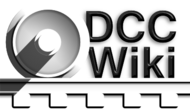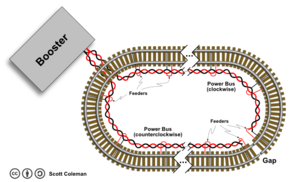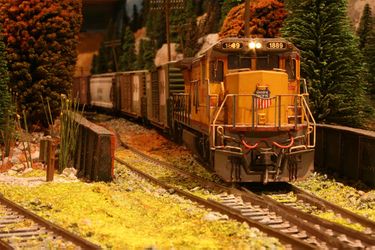Main Page
Getting started
Core Concepts
Primary components of a DCC system:
Beyond Basics
- Using Computers
- Signaling
- Layout Command Control
- Command Control History
- Sound
- Turnouts
- Power Districts
Other topics
- Frequently Asked Questions
- Configuration Variables
- PECO Electrofrog
- In the garden
- DIY DCC Projects
- DCC Software
- Decoder Reset
- Curated Videos - See helpful videos (New)
Wiring for DCC
While wiring can be easier than DC, you will eventually need to run more than 2 wires to your layout. Total beginer? - Be sure to read the Beginner's Guide to Digital Command Control first. The primary Wiring for Digital Command Control portal provides a complete list of wiring topics.
DCC manufacturers want you to think you can run your entire layout using just 2 wires. This doesn't account for buses, feeders, networking wires, power cords, throttle networks, etc.
- Converting to DCC - If you are currently using DC, this article can help you get started on converting an existing layout to DCC.
- Wiring Your Layout - Great overview of things you'll need to be prepared to wire and provides best practices.
- Wiring Tools - You'll need some basic tools to successfully wire you're layout - learn about various hand and power tools that will can save you time and frustration.
- Wire Sizes and Spacing - Using the wrong wire size can cause layout problems down the road. Plan ahead and use the correct wire for smooth operations.
- Soldering - Learn about soldering track wires to provide a long-lasting physical and electrical connection. Provides helpful tips and cautions when soldering.
About Us
DCCWiki is an encyclopedia for sharing information about Digital Command Control (DCC) as defined by NMRA used in railroad modelling. We also started a new section for the new Layout Command Control (LCC) standard from the NMRA which can be used to enhance your layout with signalling, accessory control, and other features.
DCCTalk Forum
DCCWiki's new DCC forum is located at DCCTalk.com. This is a great place to get help on anything DCC or DCCWiki related. You'll need to create an account or login before posting to the forum.
Share with us
Anyone can create and edit pages. To get started, first create an account or login. Next, start editing. That's it!



